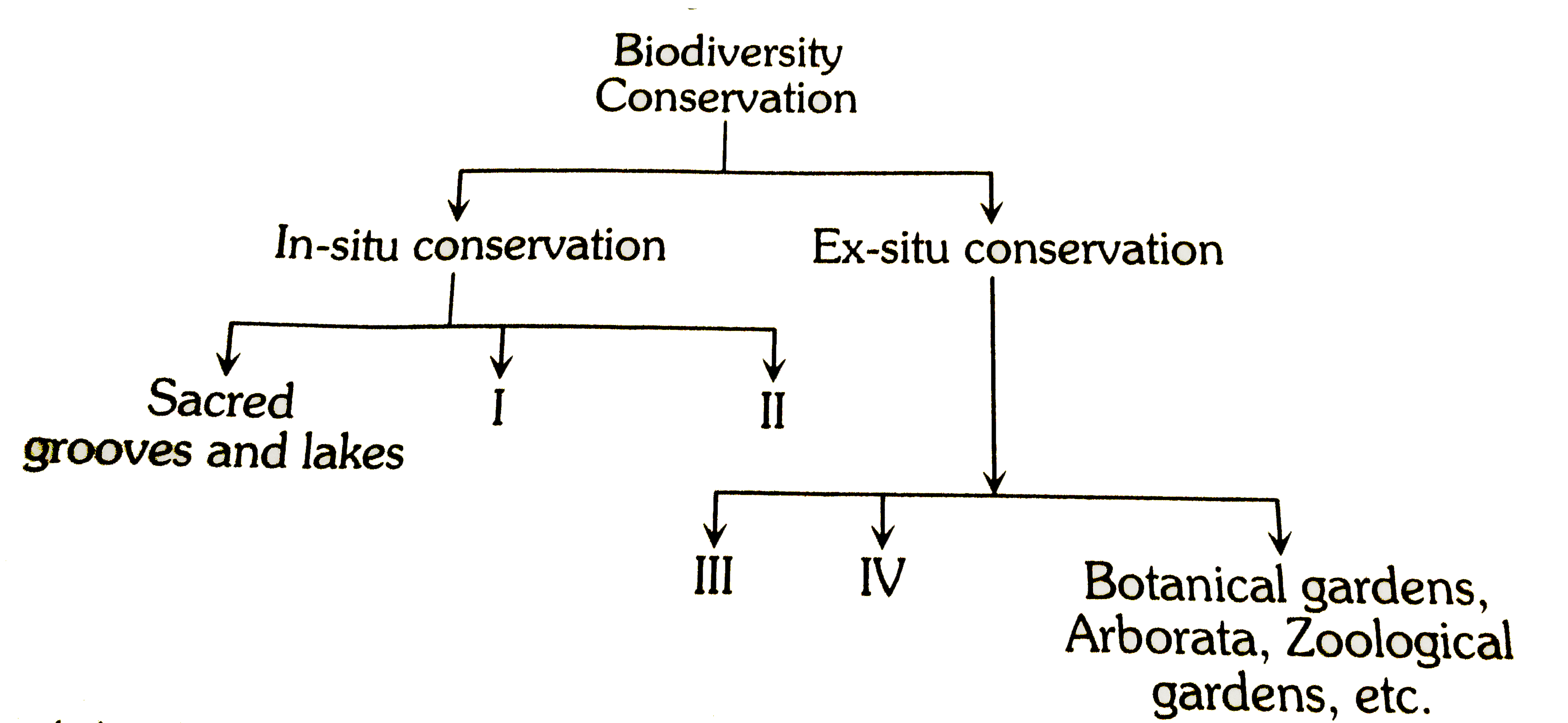The following is a incomplete flow chart depicting in - situ and ex-situ approaches of conserving biodiversity. Critically study and fill in the blanks I, II, III and IV 
Video Solution
Text Solution
(a) Biosphere reserves (b) National parks and Wildlife sanctuaries (c ) Sacred plants, Home gardens (d) Seed banks, field gene banks, cryopreservation etc.

|
Topper's Solved these Questions
- BIODIVERSITY AND CONSERVATION BOOK - PRADEEPCHAPTER - BIODIVERSITY AND CONSERVATION EXERCISE - PRACTICE QUESTION (MULTIPLE CHOICE QUESTIONS )
78 Videos
- BIODIVERSITY AND CONSERVATION BOOK - PRADEEPCHAPTER - BIODIVERSITY AND CONSERVATION EXERCISE - PRACTICE QUESTION (ASSERTION REASON TYPE QUESTIONS )
10 Videos
- BIODIVERSITY AND CONSERVATION BOOK - PRADEEPCHAPTER - BIODIVERSITY AND CONSERVATION EXERCISE - ADDITIONAL QUESTIONS (LONG ANSWER TYPE )
16 Videos
- BIOTECHNOLOGY AND ITS APPLICATIONS BOOK - PRADEEPCHAPTER - BIOTECHNOLOGY AND ITS APPLICATIONS EXERCISE - NCERT EXERCISES PRACTICE QUESTION (II. Assertion Reason Type Question)
14 Videos
Similar Questions
Knowledge Check
The following is a incomplete flow chart depicting in - situ and ex-situ approaches of conserving biodiversity. Critically study and fill in the blanks I, II, III and IV
 AI - Biosphere reserves, II - National parks and wildlife sanctuaries, III - Sacred plants, Home gardens, IV - Seed banks, field gene banks, cryopreservation, etc.BI - Sacred plants, Home gardens, II - National parks and wildlife sanctuaries, III - Biosphere reserves, IV - Seed banks, field gene banks, cryopreservation, etC.CI - Biosphere reserves, II - Seed banks, field gene banks, cryopreservation, etc., III - Sacred plants, Home gardens, IV - National parks and wildlife sanctuaries.DI - Biosphere reserves, II - Sacred plants, Home gardens, III - National parks and wildlife sanctuaries, IV - Seed-banks, field gene banks, cryopreservation, etc.
AI - Biosphere reserves, II - National parks and wildlife sanctuaries, III - Sacred plants, Home gardens, IV - Seed banks, field gene banks, cryopreservation, etc.BI - Sacred plants, Home gardens, II - National parks and wildlife sanctuaries, III - Biosphere reserves, IV - Seed banks, field gene banks, cryopreservation, etC.CI - Biosphere reserves, II - Seed banks, field gene banks, cryopreservation, etc., III - Sacred plants, Home gardens, IV - National parks and wildlife sanctuaries.DI - Biosphere reserves, II - Sacred plants, Home gardens, III - National parks and wildlife sanctuaries, IV - Seed-banks, field gene banks, cryopreservation, etc.Given below are pie diagrams A, B and C related to proportionate number of species of major taxa of invertebrates, vartebrates and plants respectively. Critically study and fill in the blanks (a), (b), (c ) and (d).
 AI - Molluscs, II - Amphibians, III - Fungi, IV - AngiospermsBI - Molluscs, II - Amphibians, III - Angiosperms, IV - FungiCI - Hexapoda, II - Amphibians, III - Fungi, IV - AngiospermsDI - Turtles, II - Amphibians, III - Fungi, IV - Angiosperms
AI - Molluscs, II - Amphibians, III - Fungi, IV - AngiospermsBI - Molluscs, II - Amphibians, III - Angiosperms, IV - FungiCI - Hexapoda, II - Amphibians, III - Fungi, IV - AngiospermsDI - Turtles, II - Amphibians, III - Fungi, IV - AngiospermsWhich one of the following methods does not fall under ex situ conservation of biodiversity?
ACryopreservationBIn vitro cultureCGene BankDBiosphere reserves
List six advantages of "ex-situ" approach to conservation of biodiversity.
View SolutionDifferentiate between in-situ and ex-situ approaches for conserving biodiversity. Give an example for each.
View SolutionGiven below is an incomplete flow chart showing influence of hormone on gametogenesis in male, observe the flow chart carefully and fill in the blank A, B, C and D.

View SolutionGiven below is an incomplete flow chart showing formation of gamete in angiospermic plant. Observe the flow chart carefully and fill in the blank A, B, C and D.

View SolutionGiven below is an incomplete flow chart showing influence of hormones on gametogenesis in males. Observe the flow chart carefully and fill in the blanks A,B,C and D.

View Solution
